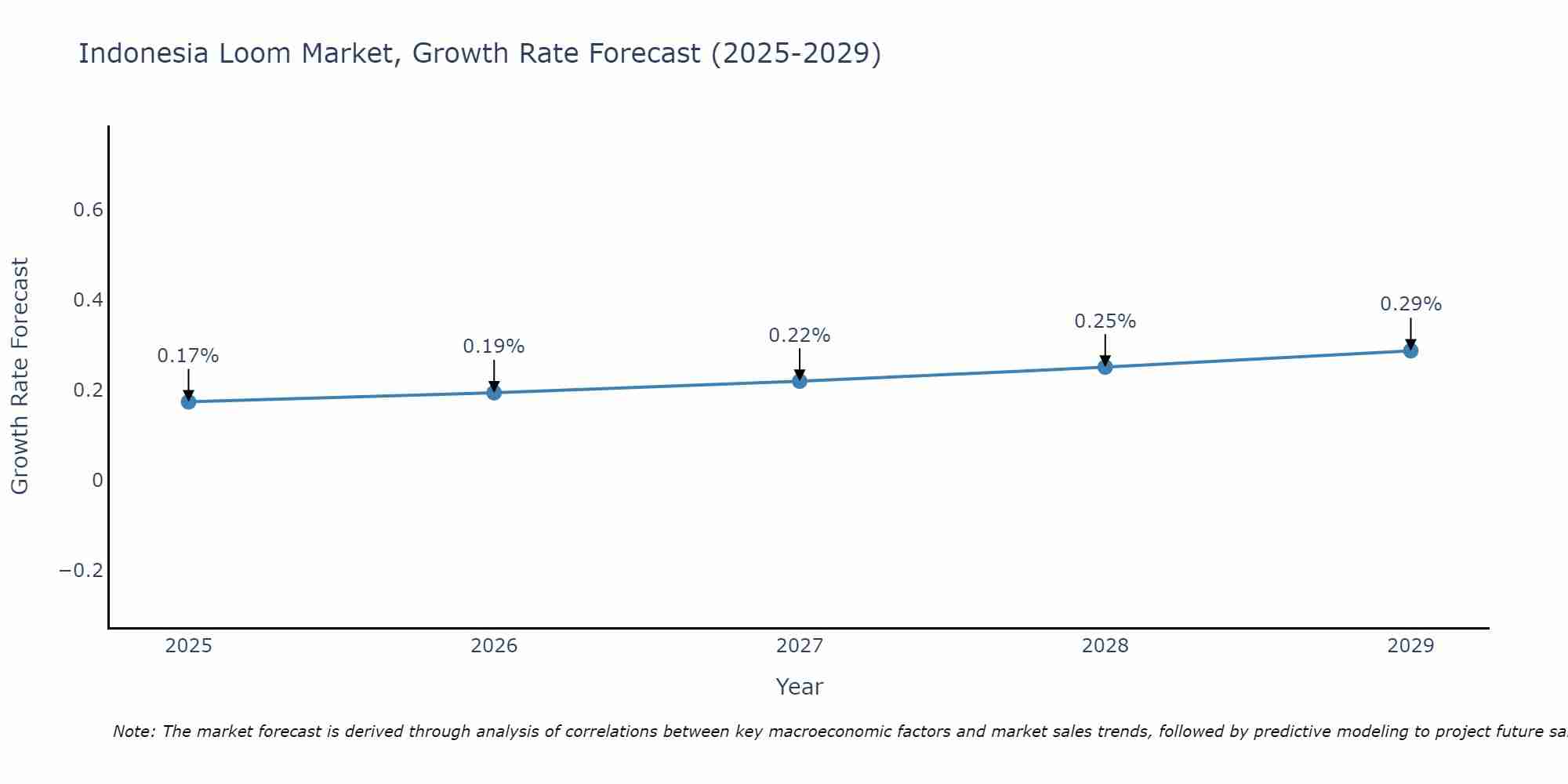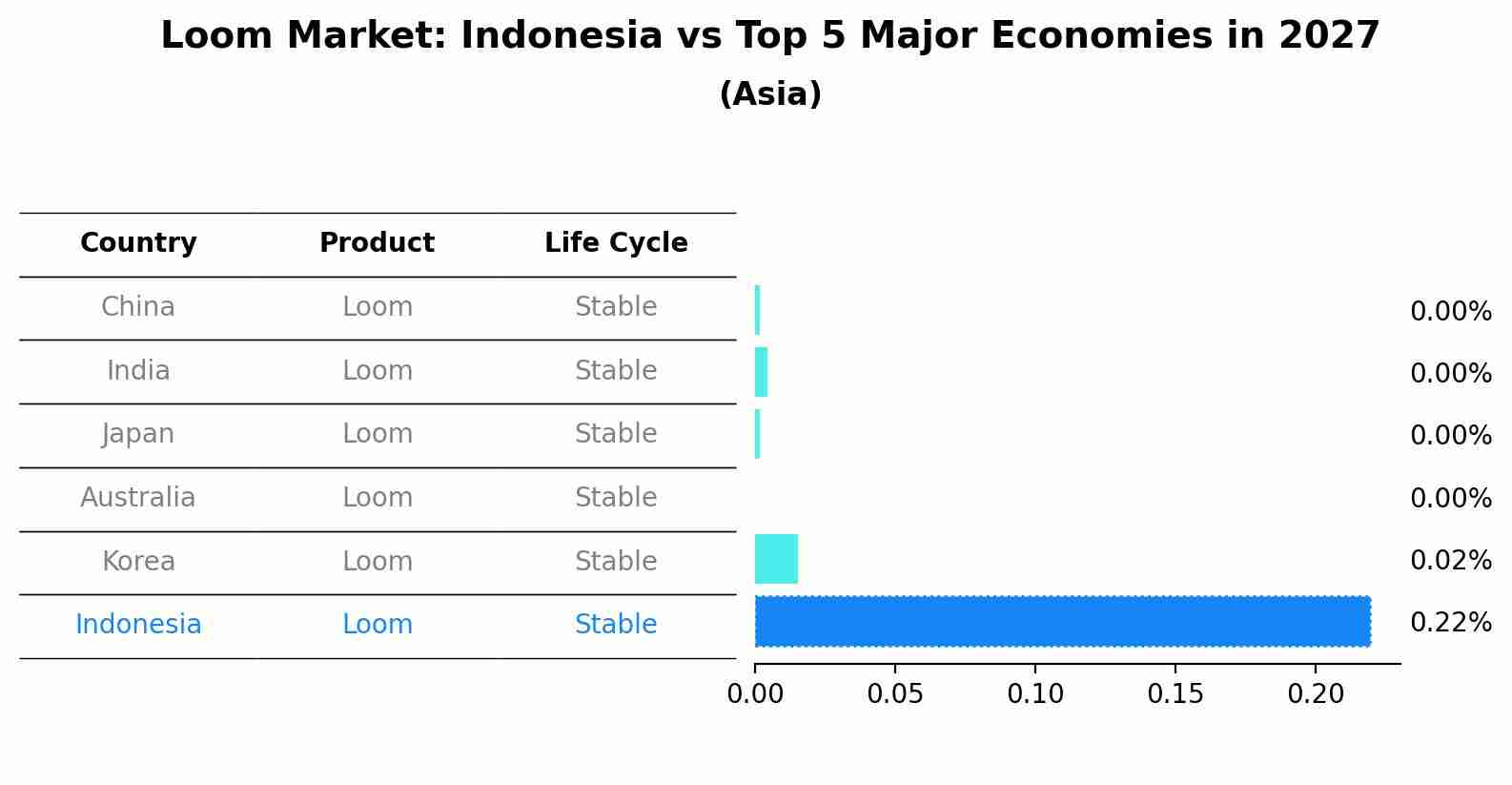Indonesia Loom Market (2025-2031) Outlook | Analysis, Companies, Forecast, Revenue, Size, Industry, Share, Value, Trends & Growth
| Product Code: ETC428844 | Publication Date: Oct 2022 | Updated Date: Aug 2025 | Product Type: Market Research Report | |
| Publisher: 6Wresearch | No. of Pages: 75 | No. of Figures: 35 | No. of Tables: 20 | |
Indonesia Loom Market Size Growth Rate
The Indonesia Loom Market is poised for steady growth rate improvements from 2025 to 2029. From 0.17% in 2025, the growth rate steadily ascends to 0.29% in 2029.

Loom Market: Indonesia vs Top 5 Major Economies in 2027 (Asia)
Indonesia's Loom market is anticipated to experience a stable growth rate of 0.22% by 2027, reflecting trends observed in the largest economy China, followed by India, Japan, Australia and South Korea.

Indonesia Loom Market Synopsis
The Indonesia loom market is vital to the textile and garment industry. Looms are essential tools for weaving fabrics, and the market is driven by the country`s growing textile manufacturing sector. With increasing domestic and international demand for Indonesia textiles, the loom market is expected to expand further as manufacturers seek advanced and efficient weaving technologies.
Drivers of the Market
The Indonesia Loom market is poised for steady growth due to several key drivers. The textile industry in Indonesia is expanding, driven by increasing consumer demand for clothing and textiles. Looms play a vital role in textile production, and as the industry grows, so does the demand for modern and efficient loom machines. Additionally, the government`s focus on promoting the textile and garment sector through incentives and infrastructure development is expected to further boost the loom market. Moreover, the trend towards sustainable and eco-friendly textiles is driving investments in modern loom technology that can produce eco-friendly fabrics efficiently.
Challenges of the Market
The Indonesia Loom market confronts numerous challenges. One of the most prominent issues is the adoption of modern textile machinery and automation. Traditional handloom weavers face competition from large-scale automated textile manufacturing, which can produce fabrics more efficiently and cost-effectively. Labor costs and skill shortages can also be obstacles in this industry. Moreover, access to quality raw materials and the need to maintain product quality standards can be challenging, especially for smaller players. Lastly, fluctuating consumer preferences and fashion trends require rapid adaptation and innovation.
COVID-19 Impact on the Market
The pandemic initially disrupted the loom market due to supply chain disruptions and labor shortages. However, as people spent more time at home, there was an increased demand for textiles and clothing, which eventually led to a recovery in the market. The adoption of e-commerce platforms for textile sales also played a crucial role in sustaining the market during the pandemic.
Key Players in the Market
Key players in the Indonesia loom market, including textile machinery manufacturers like PT Tyfountex Indonesia, provide looms used in the textile industry for weaving fabrics, contributing to textile production.
Key Highlights of the Report:
- Indonesia Loom Market Outlook
- Market Size of Indonesia Loom Market, 2024
- Forecast of Indonesia Loom Market, 2031
- Historical Data and Forecast of Indonesia Loom Revenues & Volume for the Period 2021-2031
- Indonesia Loom Market Trend Evolution
- Indonesia Loom Market Drivers and Challenges
- Indonesia Loom Price Trends
- Indonesia Loom Porter's Five Forces
- Indonesia Loom Industry Life Cycle
- Historical Data and Forecast of Indonesia Loom Market Revenues & Volume By Type for the Period 2021-2031
- Historical Data and Forecast of Indonesia Loom Market Revenues & Volume By Hand Loom for the Period 2021-2031
- Historical Data and Forecast of Indonesia Loom Market Revenues & Volume By Shuttle Loom for the Period 2021-2031
- Historical Data and Forecast of Indonesia Loom Market Revenues & Volume By Modern Loom for the Period 2021-2031
- Historical Data and Forecast of Indonesia Loom Market Revenues & Volume By Projectile Loom for the Period 2021-2031
- Historical Data and Forecast of Indonesia Loom Market Revenues & Volume By Air Jet Loom for the Period 2021-2031
- Historical Data and Forecast of Indonesia Loom Market Revenues & Volume By Multiphase Loom for the Period 2021-2031
- Historical Data and Forecast of Indonesia Loom Market Revenues & Volume By Applications for the Period 2021-2031
- Historical Data and Forecast of Indonesia Loom Market Revenues & Volume By Home Use for the Period 2021-2031
- Historical Data and Forecast of Indonesia Loom Market Revenues & Volume By Commercial Use for the Period 2021-2031
- Indonesia Loom Import Export Trade Statistics
- Market Opportunity Assessment By Type
- Market Opportunity Assessment By Applications
- Indonesia Loom Top Companies Market Share
- Indonesia Loom Competitive Benchmarking By Technical and Operational Parameters
- Indonesia Loom Company Profiles
- Indonesia Loom Key Strategic Recommendations
Frequently Asked Questions About the Market Study (FAQs):
1 Executive Summary |
2 Introduction |
2.1 Key Highlights of the Report |
2.2 Report Description |
2.3 Market Scope & Segmentation |
2.4 Research Methodology |
2.5 Assumptions |
3 Indonesia Loom Market Overview |
3.1 Indonesia Country Macro Economic Indicators |
3.2 Indonesia Loom Market Revenues & Volume, 2021 & 2031F |
3.3 Indonesia Loom Market - Industry Life Cycle |
3.4 Indonesia Loom Market - Porter's Five Forces |
3.5 Indonesia Loom Market Revenues & Volume Share, By Type, 2021 & 2031F |
3.6 Indonesia Loom Market Revenues & Volume Share, By Applications, 2021 & 2031F |
4 Indonesia Loom Market Dynamics |
4.1 Impact Analysis |
4.2 Market Drivers |
4.2.1 Increasing demand for traditional Indonesian textiles and fabrics |
4.2.2 Growing awareness and appreciation for handcrafted products |
4.2.3 Rise in tourism leading to higher demand for authentic Indonesian products |
4.3 Market Restraints |
4.3.1 High competition from machine-made textiles |
4.3.2 Fluctuating raw material prices |
4.3.3 Limited access to distribution channels for small-scale weavers |
5 Indonesia Loom Market Trends |
6 Indonesia Loom Market, By Types |
6.1 Indonesia Loom Market, By Type |
6.1.1 Overview and Analysis |
6.1.2 Indonesia Loom Market Revenues & Volume, By Type, 2021-2031F |
6.1.3 Indonesia Loom Market Revenues & Volume, By Hand Loom, 2021-2031F |
6.1.4 Indonesia Loom Market Revenues & Volume, By Shuttle Loom, 2021-2031F |
6.1.5 Indonesia Loom Market Revenues & Volume, By Modern Loom, 2021-2031F |
6.1.6 Indonesia Loom Market Revenues & Volume, By Projectile Loom, 2021-2031F |
6.1.7 Indonesia Loom Market Revenues & Volume, By Air Jet Loom, 2021-2031F |
6.1.8 Indonesia Loom Market Revenues & Volume, By Multiphase Loom, 2021-2031F |
6.2 Indonesia Loom Market, By Applications |
6.2.1 Overview and Analysis |
6.2.2 Indonesia Loom Market Revenues & Volume, By Home Use, 2021-2031F |
6.2.3 Indonesia Loom Market Revenues & Volume, By Commercial Use , 2021-2031F |
7 Indonesia Loom Market Import-Export Trade Statistics |
7.1 Indonesia Loom Market Export to Major Countries |
7.2 Indonesia Loom Market Imports from Major Countries |
8 Indonesia Loom Market Key Performance Indicators |
8.1 Percentage increase in online searches for Indonesian traditional textiles |
8.2 Number of tourists purchasing loom products as souvenirs |
8.3 Growth in the number of workshops or training programs for traditional weaving techniques |
9 Indonesia Loom Market - Opportunity Assessment |
9.1 Indonesia Loom Market Opportunity Assessment, By Type, 2021 & 2031F |
9.2 Indonesia Loom Market Opportunity Assessment, By Applications, 2021 & 2031F |
10 Indonesia Loom Market - Competitive Landscape |
10.1 Indonesia Loom Market Revenue Share, By Companies, 2024 |
10.2 Indonesia Loom Market Competitive Benchmarking, By Operating and Technical Parameters |
11 Company Profiles |
12 Recommendations |
13 Disclaimer |
- Single User License$ 1,995
- Department License$ 2,400
- Site License$ 3,120
- Global License$ 3,795
Search
Related Reports
- ASEAN Bearings Market (2025-2031) | Strategy, Consumer Insights, Analysis, Investment Trends, Opportunities, Growth, Size, Share, Industry, Revenue, Segments, Value, Segmentation, Supply, Forecast, Restraints, Outlook, Competition, Drivers, Trends, Demand, Pricing Analysis, Competitive, Strategic Insights, Companies, Challenges
- Europe Flooring Market (2025-2031) | Outlook, Share, Industry, Trends, Forecast, Companies, Revenue, Size, Analysis, Growth & Value
- Saudi Arabia Manlift Market (2025-2031) | Outlook, Size, Growth, Trends, Companies, Industry, Revenue, Value, Share, Forecast & Analysis
- Uganda Excavator, Crane, and Wheel Loaders Market (2025-2031) | Strategy, Consumer Insights, Analysis, Investment Trends, Opportunities, Growth, Size, Share, Industry, Revenue, Segments, Value, Segmentation, Supply, Forecast, Restraints, Outlook, Competition, Drivers, Trends, Demand, Pricing Analysis, Competitive, Strategic Insights, Companies, Challenges
- Rwanda Excavator, Crane, and Wheel Loaders Market (2025-2031) | Strategy, Consumer Insights, Analysis, Investment Trends, Opportunities, Growth, Size, Share, Industry, Revenue, Segments, Value, Segmentation, Supply, Forecast, Restraints, Outlook, Competition, Drivers, Trends, Demand, Pricing Analysis, Competitive, Strategic Insights, Companies, Challenges
- Kenya Excavator, Crane, and Wheel Loaders Market (2025-2031) | Strategy, Consumer Insights, Analysis, Investment Trends, Opportunities, Growth, Size, Share, Industry, Revenue, Segments, Value, Segmentation, Supply, Forecast, Restraints, Outlook, Competition, Drivers, Trends, Demand, Pricing Analysis, Competitive, Strategic Insights, Companies, Challenges
- Angola Excavator, Crane, and Wheel Loaders Market (2025-2031) | Strategy, Consumer Insights, Analysis, Investment Trends, Opportunities, Growth, Size, Share, Industry, Revenue, Segments, Value, Segmentation, Supply, Forecast, Restraints, Outlook, Competition, Drivers, Trends, Demand, Pricing Analysis, Competitive, Strategic Insights, Companies, Challenges
- Israel Intelligent Transport System Market (2025-2031) | Strategy, Consumer Insights, Analysis, Investment Trends, Opportunities, Growth, Size, Share, Industry, Revenue, Segments, Value, Segmentation, Supply, Forecast, Restraints, Outlook, Competition, Drivers, Trends, Demand, Pricing Analysis, Competitive, Strategic Insights, Companies, Challenges
- Uganda Precast and Aggregate Market (2025-2031) | Strategy, Consumer Insights, Analysis, Investment Trends, Opportunities, Growth, Size, Share, Industry, Revenue, Segments, Value, Segmentation, Supply, Forecast, Restraints, Outlook, Competition, Drivers, Trends, Demand, Pricing Analysis, Competitive, Strategic Insights, Companies, Challenges
- Australia IT Asset Disposal Market (2025-2031) | Strategy, Consumer Insights, Analysis, Investment Trends, Opportunities, Growth, Size, Share, Industry, Revenue, Segments, Value, Segmentation, Supply, Forecast, Restraints, Outlook, Competition, Drivers, Trends, Demand, Pricing Analysis, Competitive, Strategic Insights, Companies, Challenges
Industry Events and Analyst Meet
Our Clients
Whitepaper
- Middle East & Africa Commercial Security Market Click here to view more.
- Middle East & Africa Fire Safety Systems & Equipment Market Click here to view more.
- GCC Drone Market Click here to view more.
- Middle East Lighting Fixture Market Click here to view more.
- GCC Physical & Perimeter Security Market Click here to view more.
6WResearch In News
- Doha a strategic location for EV manufacturing hub: IPA Qatar
- Demand for luxury TVs surging in the GCC, says Samsung
- Empowering Growth: The Thriving Journey of Bangladesh’s Cable Industry
- Demand for luxury TVs surging in the GCC, says Samsung
- Video call with a traditional healer? Once unthinkable, it’s now common in South Africa
- Intelligent Buildings To Smooth GCC’s Path To Net Zero













